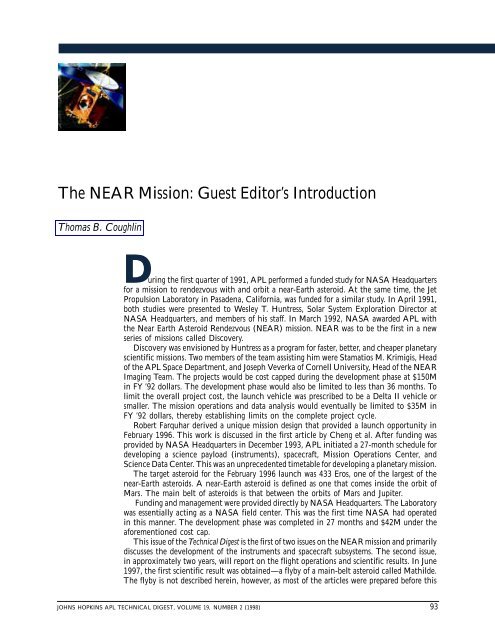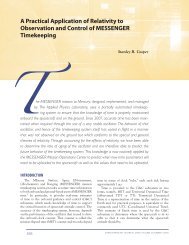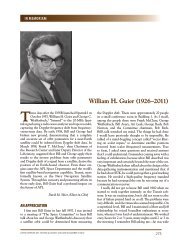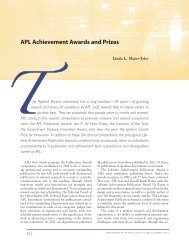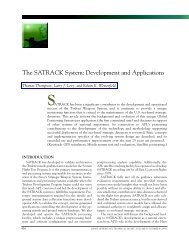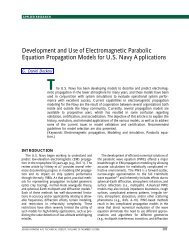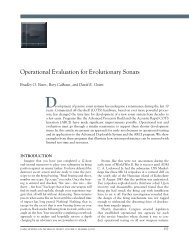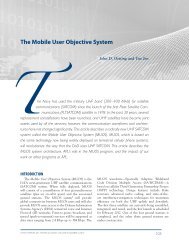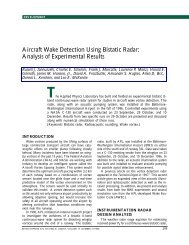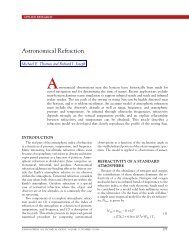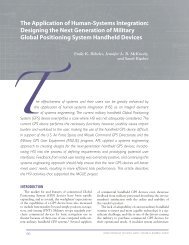The NEAR Mission: Guest Editor's Introduction - Johns Hopkins APL ...
The NEAR Mission: Guest Editor's Introduction - Johns Hopkins APL ...
The NEAR Mission: Guest Editor's Introduction - Johns Hopkins APL ...
You also want an ePaper? Increase the reach of your titles
YUMPU automatically turns print PDFs into web optimized ePapers that Google loves.
<strong>The</strong> <strong>NEAR</strong> <strong>Mission</strong>: <strong>Guest</strong> Editor’s <strong>Introduction</strong><br />
Thomas B. Coughlin<br />
<strong>NEAR</strong> EARTH ASTEROID RENDEZVOUS<br />
During the first quarter of 1991, <strong>APL</strong> performed a funded study for NASA Headquarters<br />
for a mission to rendezvous with and orbit a near-Earth asteroid. At the same time, the Jet<br />
Propulsion Laboratory in Pasadena, California, was funded for a similar study. In April 1991,<br />
both studies were presented to Wesley T. Huntress, Solar System Exploration Director at<br />
NASA Headquarters, and members of his staff. In March 1992, NASA awarded <strong>APL</strong> with<br />
the Near Earth Asteroid Rendezvous (<strong>NEAR</strong>) mission. <strong>NEAR</strong> was to be the first in a new<br />
series of missions called Discovery.<br />
Discovery was envisioned by Huntress as a program for faster, better, and cheaper planetary<br />
scientific missions. Two members of the team assisting him were Stamatios M. Krimigis, Head<br />
of the <strong>APL</strong> Space Department, and Joseph Veverka of Cornell University, Head of the <strong>NEAR</strong><br />
Imaging Team. <strong>The</strong> projects would be cost capped during the development phase at $150M<br />
in FY ’92 dollars. <strong>The</strong> development phase would also be limited to less than 36 months. To<br />
limit the overall project cost, the launch vehicle was prescribed to be a Delta II vehicle or<br />
smaller. <strong>The</strong> mission operations and data analysis would eventually be limited to $35M in<br />
FY ’92 dollars, thereby establishing limits on the complete project cycle.<br />
Robert Farquhar derived a unique mission design that provided a launch opportunity in<br />
February 1996. This work is discussed in the first article by Cheng et al. After funding was<br />
provided by NASA Headquarters in December 1993, <strong>APL</strong> initiated a 27-month schedule for<br />
developing a science payload (instruments), spacecraft, <strong>Mission</strong> Operations Center, and<br />
Science Data Center. This was an unprecedented timetable for developing a planetary mission.<br />
<strong>The</strong> target asteroid for the February 1996 launch was 433 Eros, one of the largest of the<br />
near-Earth asteroids. A near-Earth asteroid is defined as one that comes inside the orbit of<br />
Mars. <strong>The</strong> main belt of asteroids is that between the orbits of Mars and Jupiter.<br />
Funding and management were provided directly by NASA Headquarters. <strong>The</strong> Laboratory<br />
was essentially acting as a NASA field center. This was the first time NASA had operated<br />
in this manner. <strong>The</strong> development phase was completed in 27 months and $42M under the<br />
aforementioned cost cap.<br />
This issue of the Technical Digest is the first of two issues on the <strong>NEAR</strong> mission and primarily<br />
discusses the development of the instruments and spacecraft subsystems. <strong>The</strong> second issue,<br />
in approximately two years, will report on the flight operations and scientific results. In June<br />
1997, the first scientific result was obtained—a flyby of a main-belt asteroid called Mathilde.<br />
<strong>The</strong> flyby is not described herein, however, as most of the articles were prepared before this<br />
JOHNS HOPKINS <strong>APL</strong> TECHNICAL DIGEST, VOLUME 19, NUMBER 2 (1998) 93
T. B. COUGHLIN<br />
event. <strong>The</strong> flyby was performed flawlessly by all elements<br />
of the <strong>NEAR</strong> team with excellent results. It was<br />
the most difficult of any flyby ever attempted, primarily<br />
because of the lack of definitive tracking of Mathilde<br />
until several hours before the flyby, which was<br />
accomplished at 10 km/s. <strong>The</strong> <strong>NEAR</strong> navigation team<br />
at the Jet Propulsion Laboratory played a significant<br />
role in this event, as well as throughout the development<br />
phase.<br />
<strong>The</strong> <strong>NEAR</strong> spacecraft was launched successfully on<br />
a Delta II 7925 vehicle on 17 February 1996, the<br />
second day of a 12-day launch window. <strong>The</strong> window<br />
each day was 1-min in duration. <strong>The</strong> launch was<br />
scrubbed on the first day because of range problems.<br />
To date, approximately eight small trajectory correction<br />
maneuvers and a major deep space maneuver have<br />
been performed. An Earth swingby will occur in January<br />
1998, and the <strong>NEAR</strong> spacecraft will finally arrive<br />
at Eros in January 1999.<br />
<strong>NEAR</strong>’s suite of instruments will provide the data<br />
needed to better understand this primitive asteroid.<br />
<strong>The</strong> instrumentation includes the Multispectral Imager,<br />
Near-Infrared Spectrometer, X-Ray/Gamma-Ray<br />
Spectrometer, Magnetometer, and Laser Rangefinder.<br />
<strong>APL</strong> played a significant role in the development<br />
of each instrument. In certain cases, the responsibility<br />
was shared with an industry partner or the<br />
Goddard Space Flight Center. <strong>The</strong> articles by Hawkins,<br />
Peacock et al., Goldsten, Lohr et al., Cole, and<br />
Hersman et al. discuss the development of the instrument<br />
suite.<br />
THE AUTHOR<br />
<strong>The</strong> articles by Hartka and Persons, Mosher and<br />
Wiley, Ercol and Krein, Jenkins et al., Strikwerda et<br />
al., Bokulic et al., Stott et al., and Burek discuss the<br />
spacecraft subsystems. <strong>The</strong> primary author of each<br />
article is the lead engineer of the subsystem discussed.<br />
One of the most satisfying aspects of the development<br />
phase was the significant cooperation of several<br />
<strong>APL</strong> Departments. <strong>The</strong> most notable effort was that<br />
of the Technical Services Department in the fabrication<br />
of the <strong>NEAR</strong> hardware. This work is described in<br />
the article by Dettmer, who led the fabrication effort.<br />
Whitworth et al. discuss the development of the<br />
<strong>Mission</strong> Operations Center, which had to be connected<br />
to the spacecraft during integration and test at <strong>APL</strong>,<br />
to Cape Kennedy during launch operations, to the<br />
Deep Space Network, and to the Science Data Center<br />
at <strong>APL</strong>. Finally, Heeres et al. provide a look at the<br />
Science Data Center. This facility was not needed to<br />
support the launch; its development will continue<br />
throughout the 3-year cruise phase.<br />
After the spacecraft arrives at Eros in January 1999,<br />
it will reduce its altitude above the surface from approximately<br />
100 km to 12 km over the 1-year orbital<br />
phase. Significant results are anticipated from this<br />
first-ever orbit of a small body. <strong>The</strong> <strong>NEAR</strong> science<br />
team, which includes people from many universities<br />
and government agencies across the country, is now in<br />
the final phase of planning the year at Eros. In February<br />
2000, the <strong>NEAR</strong> spacecraft will land on the surface of<br />
Eros, completing an extremely challenging mission.<br />
We look forward to the scientific rewards.<br />
THOMAS B. COUGHLIN holds a B.S.M.E. from the University of Maryland<br />
and an M.S.M.E. in aeronautical design from the Drexel Institute of Technology.<br />
He has served as <strong>NEAR</strong> Project Manager throughout the development,<br />
launch, and mission phase of this initial “faster, better, and cheaper” Discovery<br />
program. He is also the Programs Manager for <strong>APL</strong>’s Space Department. Mr.<br />
Coughlin has participated in several fast-track SDI programs, and for those<br />
efforts he was awarded the Distinguished Public Service Medal. His e-mail<br />
address is tom.coughlin@jhuapl.edu.<br />
94 JOHNS HOPKINS <strong>APL</strong> TECHNICAL DIGEST, VOLUME 19, NUMBER 2 (1998)


